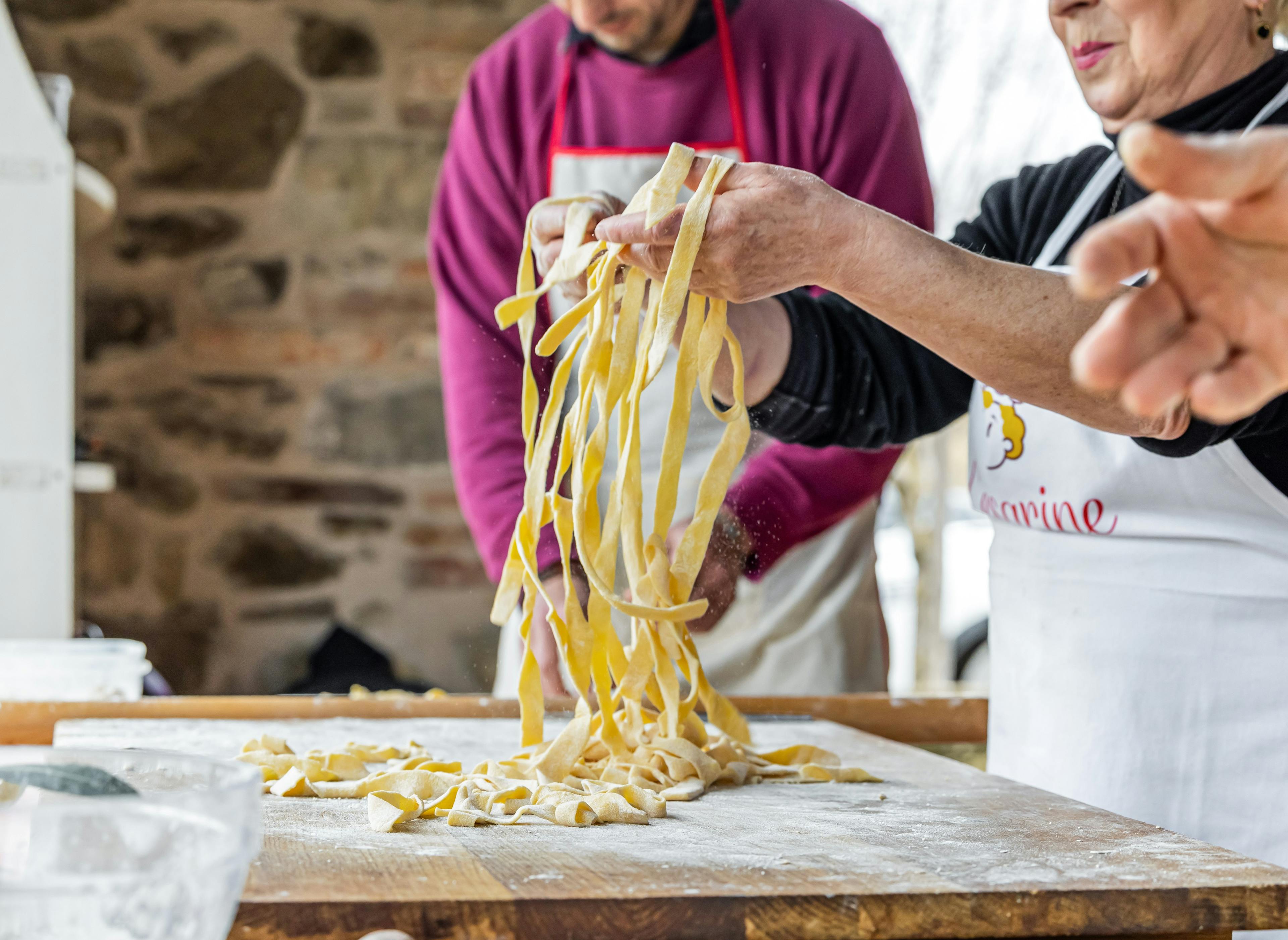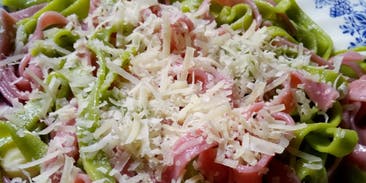

Tagliatelle is an egg pasta format with an ancient history rooted in Emilia-Romagna. They are so widespread in our daily lives that we can consider them synonymous with home, traditional warmth, family, simplicity and taste. Over the years they have become more and more a famous dish throughout Italy to the point of being known all over the world.
We suggest you the recipe for Cesarina Ewa's two-coloured tagliatelle from Syracuse, and if you need a refresher on how to make fresh egg pasta, you can read this article Fresh egg pasta recipe (‘sfoglia’) | Cesarine. You will make a flawless puff pastry.

Two-coloured tagliatelle with aubergine pesto
A recipe for fresh egg pasta typical of the Emilian tradition
Ingredients
- For the aubergine pesto:
- 2 medium aubergines
- 4 mint leaves
- 4 basil leaves
- 50 g of toasted almonds
- 50 g extra virgin olive oil
- Half a clove of garlic
- Half a lemon
- Salted ricotta
For the two-coloured tagliatelle: - 200 g hard wheat flour
- 2 eggs
- 100g fresh spinach juice for the green noodles
- 100 g red beetroot juice for red pasta
Method
For the aubergine pesto:
- Wash the aubergines thoroughly;
- Place the whole aubergines in the oven preheated to 180 degrees and bake them for about 45 minutes;
- Once cooked, remove the skin from the aubergines;
- Place the aubergine pulp in a blender and add the extra virgin olive oil, basil, almonds, mint and a squeeze of lemon;
- Blend everything until smooth.
For the green tagliatelle:
- Boil the spinach and let it drain well before using it;
- Then pour the boiled spinach into a blender and blend until smooth;
- Make a well on the pastry board with 100g of hard wheat semolina flour and make a hole in the centre;
- Add an egg and the 100g of spinach juice;
- Start kneading until you obtain a homogeneous dough;
- Once you have your dough, let it rest for about 30 minutes;
For the red tagliatelle:
- Cook the beets and blend until smooth and if necessary add a little cooking water;
- Make a well on the pastry board with 100 g of hard wheat semolina flour and make a hole in the centre;
- Add an egg and the 100 g beet juice;
- Start kneading until you obtain a homogeneous dough;
- Once you have your dough, let it rest for about 30 minutes;
To finish:
- Roll out the dough with a rolling pin to a very thin sheet and let it dry for a few minutes;
- Once dry, roll it gently on itself and cut it into strips 6-8 millimetres wide;
- Cook your tagliatelle, season with aubergine pesto and serve with a generous sprinkling of salted ricotta.
Region you go, tagliatella you find!
In Emilia, especially in Bologna, the classic recipe calls for tagliatelle to be seasoned with Bolognese ragù and generously covered with Parmigiano Reggiano. In Romagna they can also be green, prepared with spinach added to the dough, or mixed, in the so-called straw and hay form. Different seasonings are also used, such as strigoli, peas, ragù and raw ham. In Tuscany and Umbria, the most common seasoning has the scent of the underwood, with mushrooms, truffles, wild boar or duck ragout.
What is the origin of tagliatelle?
Noodles are one of the most popular pasta shapes in the world and it is practically impossible to establish with certainty who created them, so much so that stories and legends have multiplied over time.
The most famous legend about their origin takes us back to the 15th century. Lucrezia Borgia was on her way to Ferrara where she was to marry Duke Alfonso I d'Este. During a stop in Bologna, she paid a visit to Giovanni II Bentivoglio. The latter then asked a famous Bolognese cook named Zerafino to prepare a special dish in her honour. Thus, inspired by the blond hair of his bride-to-be, Zerafino created tagliatelle.
The term ‘tagliatelle’, in reference to a pasta similar to today's, is found in the 16th century, in Ferrara itself, in a treatise of the ducal order at the Este court by Cristoforo di Messisbugo, published in 1549. This document mentions the recipe for ‘lasagnuolle, or pulled tagliatelle’, suggesting a common origin with lasagne.
What is the perfect measure of tagliatelle?
In 1972, the Bologna delegation of the Accademia Italiana della Cucina deposited the recipe and measurement of the real tagliatella of Bologna with the Bologna Chamber of Commerce, Industry, Craftsmanship and Agriculture with a sample made of gold. The measurements of tagliatelle when cooked are 8 millimetres wide, equal to the 12,270th part of the Torre degli Asinelli, or about 7 mm when uncooked, while the thickness has not been precisely codified but must be between 6 and 8 tenths of a millimetre.
Cesarine's fresh pasta experiences!
Treat yourself to an unforgettable experience with our Cesarine! We have lots of fresh pasta cooking classes ready for you so you can learn the secrets of how to make a perfect pasta sheet!